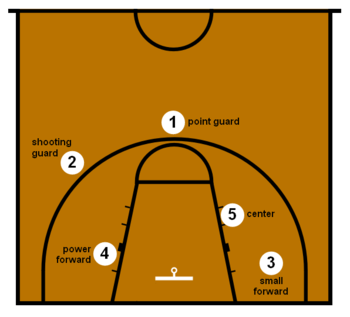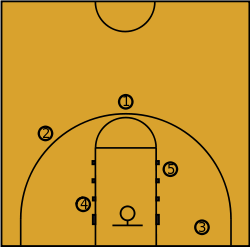Basketball positions
There are five positions in basketball. These positions are employed by all organized/unorganized basketball teams. They are defined as the point guard (PG), the shooting guard (SG), the small forward (SF), the power forward (PF), and the center (C).

- 1–Point guard
- 2–Shooting guard
- 3–Small forward
- 4–Power forward
- 5–Center
The point guard is the de facto leader of the team on the court. This position requires substantial ball-handling skills and the ability to facilitate the team during a play. The shooting guard, as the name implies, is often the best shooter, as well as being capable of shooting accurately from longer distances. The small forward often has an aggressive approach to the basket when handling the ball. The small forward is also known to make cuts to the basket in efforts to get open for shots. The power forward and the center make up the frontcourt, often acting as their team's primary rebounders or shot blockers, or receiving passes to take inside shots. The center is typically the larger of the two.
Overview
Historically, only three positions were recognized (two guards, two forwards, and one center) based on where they played on the court: Guards generally played outside and away from the hoop and forwards played inside and near the baseline, with the center usually positioned in the key. During the 1980s, the team strategy evolved after the three-point shot was added to the game. More specialized roles developed, resulting in the five position designations used today. However, individual team strategy and availability of personnel can alter the positions used by a particular team. For example, the dribble-drive motion offense and the Princeton offense use four interchangeable guards and one center. This set is also known as a "four-in and one-out" play scheme. Other combinations are also prevalent.
Besides the five basic positions, some teams use non-standard or hybrid positions, such as the point forward, a hybrid small forward/point guard; the swingman, a hybrid small forward/shooting guard; the big, a hybrid power forward/center; and the stretch four, a power forward with the shooting range of typical shooting guards.
In the early days of the sport, there was a "running guard" who brought the ball up the court and passed or attacked the basket, like a point or combo guard. There was also a "stationary guard" who made long shots and hung back on defense before there was the rule of backcourt violations.[1]
Guard
Point guard
The point guard (PG), [2] known as the one, is typically the team's best ball handler and passer. They usually are very fast and are good at driving and short-range. Therefore, they often lead their team in assists and are able to create shots for themselves and their teammates. They are quick and are able to hit shots either outside the key but a majority are inside the 3 point line or layups, largely depending on the player's skill level. Point guards are looked upon as the "floor general" or the "coach on the floor". They should study the game and game film to be able to recognize the weaknesses of the defense, and the strengths of their own offense. They are responsible for directing plays, making the position equivalent to that of quarterback in American football, playmaker in association football (soccer), center in ice hockey, or setter in volleyball. Good point guards increase team efficiency and generally have a high number of assists. They are often referred to as dribblers or play-makers. In the NBA, point guards are usually the shortest players on the team and are mostly between 5 feet 9.7 inches (1.77 m) and 6 feet 4.25 inches (1.94 m).
Shooting guard
The shooting guard (SG) is also known as the two or the off guard. Along with the small forward, a shooting guard is often referred to as a wing because of its use in common positioning tactics. As the name suggests, most shooting guards are prolific from the three-point range and long mid range. Some key aspects to being a shooting guard is having the ability to patiently and methodically circulate the three point line linear with that of the ball. This allows the ability to correctly get in open space for other positions handling the ball. Just like all positions in basketball, the ability to communicate efficiently with teammates is key. If a player's teammates do not know where/when a player will be open, they won't be able to deliver the ball when an efficient opportunity presents itself.
Besides being able to shoot the ball, shooting guards tend to be the best defender on the team, as well as being able to move without the ball to create open looks for themselves. Some shooting guards also have good ball handling skills, often creating their own shots off the dribble. A versatile shooting guard will have good passing skills, allowing them to assume point guard responsibilities known as combo guards. Bigger shooting guards also tend to play as small forwards. In the NBA, shooting guards usually range from 6 feet 0.75 inches (1.85 m) to 6 feet 7 inches (2.01 m).
Forward
Small forward
The small forward (SF), also known as the three, is considered to be the most versatile of the main five basketball positions. "Though they're not the primary ball handler, small forwards need dribbling skills. Though they're not expected to be great post players, they need to be able to post up. Though they're often not the top scoring option, they need to be able to score." [3]Versatility is key for small forwards because of the nature of their role, which resembles that of a shooting guard more often than that of a power forward. This is why the small forward and shooting guard positions are often interchangeable and referred to as wings.
Small forwards have a variety of assets, such as quickness and strength inside. One common thread among all kinds of small forwards is an ability to "get to the line" and draw fouls by aggressively attempting (post-up) plays, lay-ups, or slam dunks. As such, accurate foul shooting is a common skill for small forwards, many of whom record a large portion of their points from the foul line. Besides being able to drive to the basket, they are also good shooters from long range. They are the second-best 3 point shooters on the court along with the shooting guard and usually when stationary, sit just inside the 3 point line. Some small forwards have good passing skills, allowing them to assume point guard responsibilities as point forwards. Small forwards should be able to do a little bit of everything on the court, typically playing roles such as swing men and defensive specialists. A smaller small forward under 6 feet 5 inches (1.96 m) might play the shooting guard position some of the time and a bigger small forward taller than 6 feet 7 inches (2.01 m) might play power forward sometimes. In the NBA, small forwards usually range from 6 feet 3.5 inches (1.92 m) to 6 feet 8.25 inches (2.04 m).
Power forward
The power forward (PF), also known as the four, often plays a role similar to that of the center, down in the "post" or "low blocks". The power forward is often the team's most powerful and dependent scorer, being able to score close to the basket while also being able to shoot mid-range jump shots from 10 - 15 feet from the basket. Some power forwards have become known as stretch fours, since extending their shooting range to three-pointers. On defense, they are required to have the strength to guard bigger players close to the basket and to have the athleticism to guard quick players away from the basket. Most power forwards tend to be more versatile than centers since they can be part of plays and are not always in the low block. A tall power forward over 6 feet 10 inches (2.08 m) can be a forward-center, playing PF and C. A smaller power forward 6 feet 7 inches (2.01 m) can play combo forward, playing SF part-time. In the NBA, power forwards usually range from 6 feet 5.5 inches (1.97 m) to 6 feet 10.25 inches (2.09 m) without shoes.[4]
Center
The center (C), also known as the five, usually plays near the baseline or close to the basket (the "low post"). They are usually the tallest players on the floor. The center usually scores "down low", or "in the paint" (near the basket, in the key), but some can be good perimeter shooters. They are typically skilled at gathering rebounds, contesting shots and setting screens on players.
The center position has been traditionally considered one of the most important positions, if not the most important. The range of players used in the position has transitioned from relatively slower but much taller "back to the basket" players to players who would normally be classified as power forwards but can dominate the position with their defensive skills, or mismatch ability to shoot from the high post. This has been due to the scarcity of players possessing the combination of great skill, ideal height, and durability. This has been matched by the development of more fast-paced and athletic basketball play, which calls for less traditional center play and a more up-and-down the court play style. They are usually over 6 feet 10 inches (2.08 m) tall.
See also
References
- Robert Peterson (2002). Cages to Jump Shots: Pro Basketball's Early Years. U of Nebraska Press. pp. 84–. ISBN 0-8032-8772-0.
- ^ a b Rose, Lee H. (2016). The Basketball Handbook. Point guards pass the ball on offence and then head down the floor to set up and start the play. On defense, they guard the other point guard or one of the wings. Once they receive the ball they sprint towards the basket if it is open. If not open they stand back and wait till all of their team's layers are down the floor and pass the ball. If open for a shot they will shoot to score a few points depending on where they standing. Human Kinetics.
- "7 Habits of Successful Shooting Guards". www.usab.com. Archived from the original on 2020-02-18. Retrieved 2020-02-18.
- "Archived copy". Archived from the original on 2019-02-19. Retrieved 2019-02-18.CS1 maint: archived copy as title (link)
